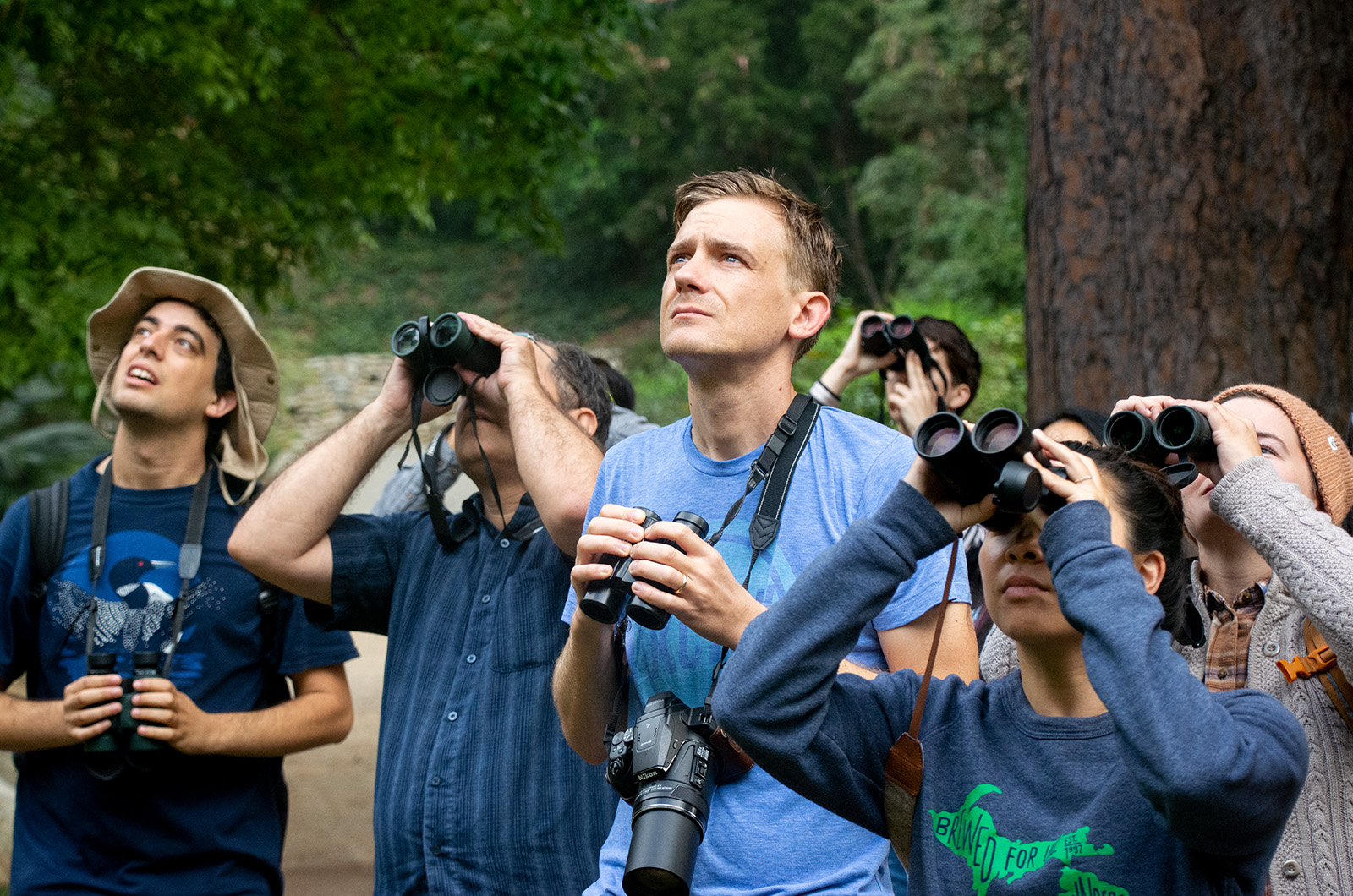Bruin Audubon Society and Birding Club makes bird-watching a hoot for students

The Bruin Audubon Society and Birding Club was founded this fall by Sam Bressler (center), a graduate student in ecology. It held birdwalks every Thursday during the first eight weeks of fall quarter to watch the birds migrating south for the winter. (Sakshi Joglekar/Daily Bruin)

By Megan McCallister
Nov. 15, 2019 1:10 a.m.
This post was updated Nov. 17 at 2:57 a.m.
Bundled in jackets against the early morning fog, with binoculars and cameras strapped across their shoulders, roughly 15 students and community members entered the UCLA Mildred E. Mathias Botanical Gardens as it opened in hopes of catching one last glimpse of the birds migrating south for the winter.
Birding involves the studying and identification of birds in their natural habitats, a hobby millions of Americans participate in.
The Bruin Audubon Society and Birding Club, founded in fall 2019, began hosting weekly bird walks through the botanical gardens at the end of September. The group most recently met Thursday for their last walk of the year, but board members still plan to hold weekend birding trips off-campus throughout the winter and spring.
“Sometimes, it can be hard to spot birds (because they move so quickly), so I might miss three in a row, but when I finally see one it’s a really gratifying feeling,” said Ella Moore, a first-year undeclared student who called herself a beginning birder.
Many of the birds the group has seen over the seven weeks of bird walks were only stopping along their way south.
Many new species, from warblers to flycatchers, can be found in trees and bushes at UCLA only during fall migrations, according to Dan Cooper, the California director of conservation for the National Audubon society and a graduate student in ecology and evolutionary biology. The only birds left now are those that will be staying for the winter.
The Bruin Audubon Society’s own journey began when Samuel Bressler, a graduate student in ecology, began organizing bird-watching trips for friends as an undergraduate at UCLA. He founded the society this fall and it was later recognized as an official chapter of the National Audubon Society.
Through the club, Bressler said he aspired to connect birders of various experience levels and provide mentors for intimidated beginners.
“I realized that there (was) a group of birders on campus that I knew, but that didn’t necessarily know each other,” Bressler said.
In 2013, the U.S. Fish & Wildlife Service reported a nationwide total of 41 million “backyard birders” and 18 million “away-from-home” birders, or birders who will travel in the course of their hobby.
Although the avocation is often self-taught, it takes practice and repetition to differentiate between species with speed and accuracy. Especially with the diversity of birds that appear in the fall, the club’s novices emphasized their appreciation for having experts as guides.
“I’m definitely no expert, so the walks are a fun, easy way to be introduced to birding because there are no expectations, and other people are really knowledgeable and helpful,” Moore said.
The most common equipment birders carry are binoculars and cameras. In a technique called pishing, they make whistling noises to attract birds and gain a closer view.
“If a student wants to try birding, I think all they would need is comfy shoes and a healthy sense of wonder, and maybe even a little bit of patience,” said community member and birder Vignesh Raguraman. “It would also definitely help to leave sarcasm at the door because it’s a wonderful activity, but it is very niche.”
To keep track of the species they encounter, birders keep various lists. Life lists, the most common type, include all the birds an individual encounters in their lifetime. Others keep year lists, which reset annually and include all the birds the watcher has seen over the course of the year.
“There’s sort of that competitive listing where you want to get your list as high as possible,” Bressler said. “Can I get it over 100? Can I get it over 200? Can I beat my friend who’s birding a different area in a different part of the country? There’s that competition element, which I really like.”
Others are drawn to bird-watching by the serenity of being surrounded by nature.
“Birding can be very meditative,” Raguraman said. “It keeps me really tied into the moment because I constantly have to adjust and keep an eye out in the trees. I have to really be present in that moment, which I think is something everyone could benefit from.”
As the year progresses, the club plans to expand into bird conservation efforts as well. Currently, board members are working on submitting a grant to the National Audubon Society to relandscape Hummingbird Alley between Franz Hall and the Geology building with native plants. The goal is to make the passage more bird- and pollinator-friendly.
Aside from during migration periods, bird-watchers often revisit the same locations in hopes of finding a species that does not belong there. Since birds can fly long distances, a slightly wrong internal migratory clock or an internal compass pointed in the wrong direction can cause the bird to end up in an unusual habitat.
“The reason I go to these places over and over and over again is for that thrill of finding something new, finding something unusual, finding something people will remember me by,” Bressler said. “I’ve had that happen to me a couple times. I’m just walking through, I’m birding a specific area, and I come upon a really rare species that shouldn’t be there.”
Given the loss of about 3 billion birds from North America since the ’70s and the predicted extinction of two-thirds of North America’s bird species due to climate change, the club is also focusing on outreach, Bressler said. He hopes that encouraging more young people to interact with birds up close will lead to a better chance of protecting them in the decades ahead.
Students who want to dabble in birding themselves can find birds at Sage Hill behind Hitch Residential Suites, behind the UCLA Anderson School of Management and at the east side of Wilson Plaza, Cooper said.
UCLA’s campus may be urban, but there is more wildlife than people might expect, said Nurit Katz, the chief sustainability officer at UCLA and a birder herself.
“There’s so much you can actually see right on campus if you just take a moment to look around,” Katz said. “So as you walk across campus, I would encourage folks to stop and listen.”


